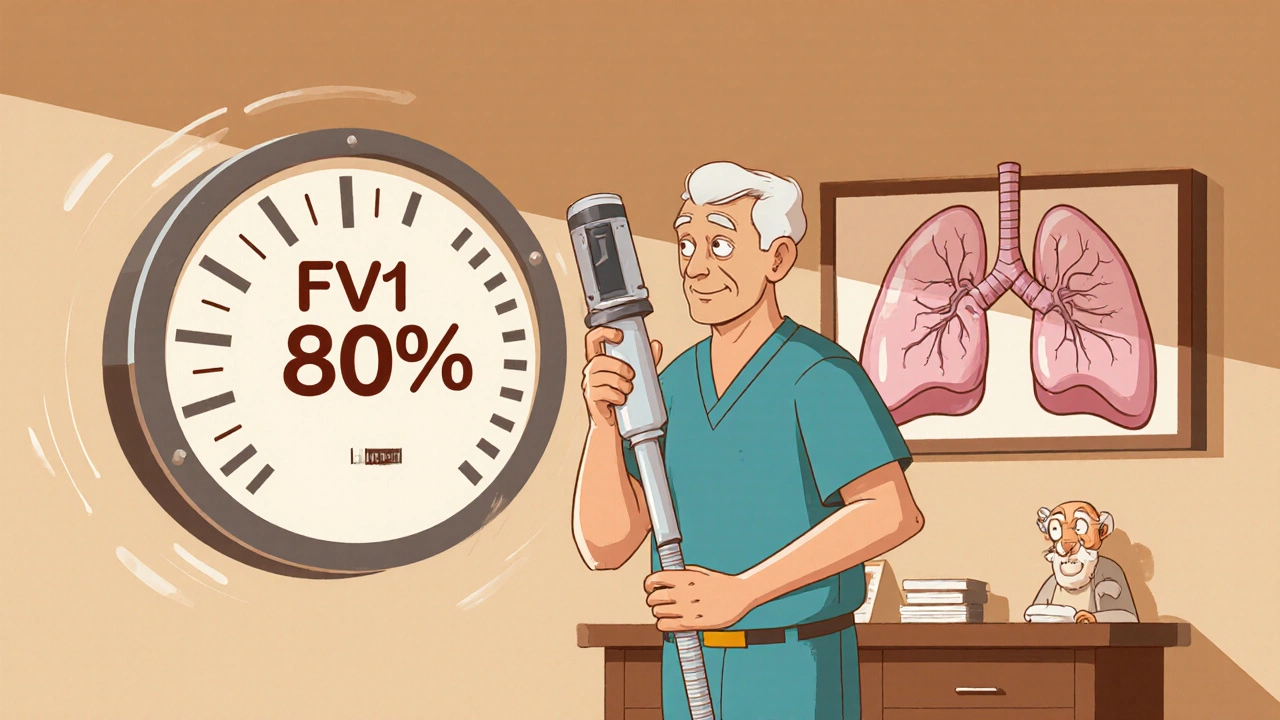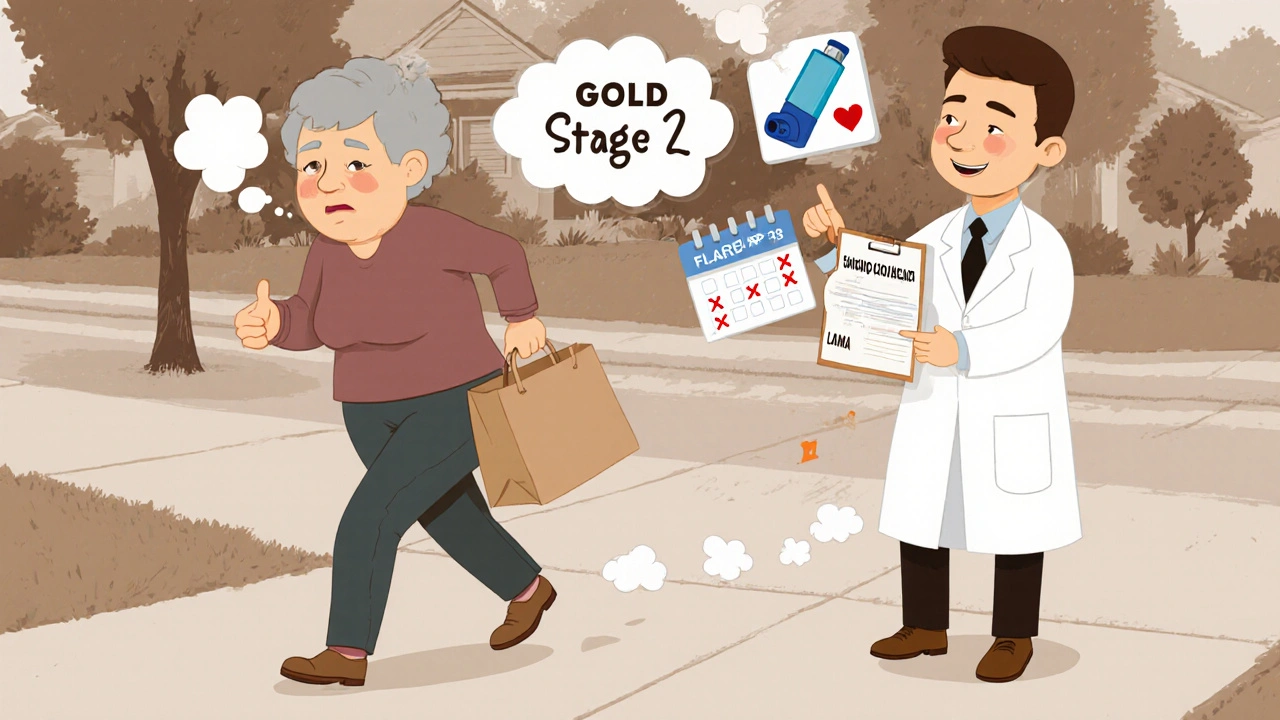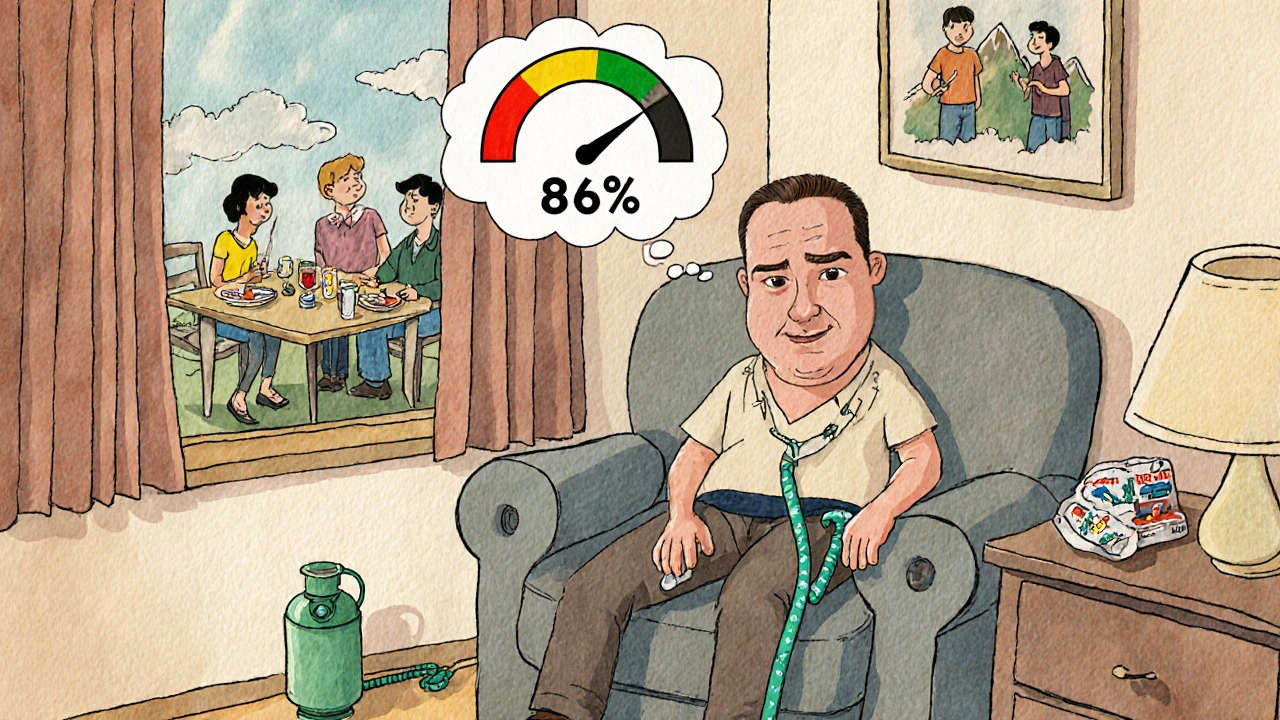COPD Stages Explained: What Mild, Moderate, and Severe Really Mean
 Nov, 16 2025
Nov, 16 2025
What COPD Stages Actually Tell You
Most people think COPD is just "bad lungs" - something that comes with age or smoking. But the truth is, COPD isn’t one thing. It’s a slow, silent progression, and knowing your COPD stage changes everything. It’s not about fear. It’s about action. The right stage tells you what treatments work, what to watch for, and how to keep living well - even when your lungs feel like they’re working against you.
The system doctors use to define COPD stages is called GOLD - short for Global Initiative for Chronic Obstructive Lung Disease. It’s not just a label. It’s a roadmap. And it’s based on one simple number: your FEV1. That’s how much air you can forcefully blow out in one second, compared to what a healthy person your age and size should be able to do. It’s measured with a spirometer - a simple machine you blow into during a quick test. If your FEV1 is below 70% of your predicted normal after using a bronchodilator, you have COPD. From there, it’s broken into four stages.
Stage 1: Mild COPD - The Silent Start
Stage 1 COPD means your FEV1 is 80% or higher. Sounds fine, right? But here’s the catch: most people in this stage don’t know they have it. They think they’re just out of shape. Or getting older. Or that coughing in the morning is normal.
At this stage, you might notice shortness of breath only when you’re walking fast, climbing a hill, or carrying groceries. You might have a daily cough with phlegm - especially in winter. But you push through. You don’t stop. You don’t get tested.
That’s the problem. According to the CDC, people with early COPD wait an average of 5.2 years before getting diagnosed. By then, damage is done. But here’s the good news: Stage 1 is the best time to act. Quitting smoking right now can cut your lung decline in half. Instead of losing 60 mL of lung function per year, you’ll drop to 30 mL. That’s not just slowing it down - that’s buying you years.
Pulmonary rehab isn’t usually recommended yet, but if you’re still smoking, that’s your first step. No medication? Maybe not. But if you’re coughing a lot, a short-acting inhaler like albuterol can help when you need it. And get your flu shot. Every year. It cuts your risk of a bad flare-up by 32%.
Stage 2: Moderate COPD - The Turning Point
Stage 2 means your FEV1 is between 50% and 79%. This is where symptoms start to interfere with daily life. You stop to catch your breath every few minutes on level ground. Walking to the mailbox feels like a workout. You’re tired more often. Your cough is constant. Mucus builds up. You start avoiding things you used to enjoy - like family walks or weekend shopping.
Doctors will likely start you on long-acting bronchodilators - either LAMA (like tiotropium) or LABA (like formoterol). These aren’t quick fixes. They’re maintenance. They open your airways for 12 to 24 hours. In clinical trials, they improve FEV1 by 100-150 mL on average. That might not sound like much, but it means you can walk further, breathe easier, and sleep better.
Pulmonary rehab becomes critical here. It’s not just exercise. It’s breathing training, nutrition advice, and emotional support. People who complete rehab increase their 6-minute walk distance by 45 to 75 meters. That’s the difference between needing help to get dressed and doing it yourself.
And here’s something most don’t realize: your stage isn’t just about FEV1. The GOLD system now groups you into A, B, C, or D based on symptoms and flare-ups. You could have Stage 2 COPD but be in Group D - meaning you have high symptoms and frequent flare-ups. That changes your treatment. You might need a combo inhaler with two long-acting drugs. Or even inhaled steroids if your blood test shows high eosinophils (above 300 cells/μL). That reduces flare-ups by 25%.
Don’t wait for a hospital visit to realize you’re in trouble. If you’ve had two or more flare-ups in a year, you’re at high risk. And each one increases your chance of dying within the next year by 22%.

Stage 3: Severe COPD - The Reality Check
Stage 3 COPD hits when your FEV1 drops to 30-49%. This isn’t just "feeling winded." This is breathing becoming a full-time job. You get out of breath putting on socks. You need to rest after making coffee. Your oxygen levels drop below 90% during normal activities. You’re not lazy - your lungs are failing.
At this point, you’re likely on a combination of LAMA and LABA. If you’re still having flare-ups, your doctor may add inhaled steroids. But steroids aren’t magic. They help only if your body is showing signs of inflammation - like high eosinophils. If you’re not a candidate, they won’t help and might even cause side effects like thrush or bone thinning.
Supplemental oxygen? Maybe not yet. But if your SpO2 drops below 88% during activity, you’ll need it. Not just at night - during the day too. Many people here start using portable oxygen tanks just to get through errands.
One of the hardest parts? Being dismissed. On Reddit, a user with an FEV1 of 38% said, "My doctors keep saying I’m ‘only’ Stage 3, so I must be exaggerating." But Stage 3 isn’t "mild." It’s severe. And it’s not just about lungs. Sixty-five percent of people at this stage also have heart problems. COPD doesn’t just hurt your breathing - it strains your heart, your muscles, your mind.
Annual 6-minute walk tests are now standard. They measure how far you can go before stopping. It’s a better predictor of survival than FEV1 alone. And if you’re not doing it, ask your doctor why.
Stage 4: Very Severe COPD - The Fight for Every Breath
Stage 4 means your FEV1 is below 30%. This is the point where breathing becomes exhausting, constant, and life-altering. You’re on oxygen 15 hours a day or more. Simple tasks like showering or talking on the phone require planning. You panic when you can’t catch your breath. You avoid social events because you’re afraid of running out of air.
Oxygen therapy is no longer optional. It’s life-saving. The NOTT trial showed that using oxygen at least 15 hours a day boosts one-year survival from 73% to 90%. That’s not a small gain - that’s a game-changer.
Non-invasive ventilation (NIV) may be added. It’s a machine you wear at night that helps you breathe without a tube down your throat. It reduces hospital readmissions by 28%. Many people don’t know this option exists - but if you’re waking up tired, with headaches, or feeling foggy in the morning, it might be time to ask.
Flare-ups are dangerous. Each one carries a 22% risk of death within the year. That’s why many at this stage carry a rescue pack - antibiotics and steroids - to start immediately if symptoms worsen. Waiting for a doctor’s appointment could be fatal.
Financial stress hits hard. Oxygen equipment costs $287 a month out-of-pocket, even with Medicare. Many skip refills. Others isolate themselves because they’re embarrassed. One patient said, "I don’t go to family dinners anymore. I can’t sit still long enough to eat."

Why Staging Matters More Than You Think
Staging isn’t about labeling you. It’s about matching treatment to your reality. Two people with the same FEV1 can have completely different needs. One might be in Group A - low symptoms, low flare-ups - and need just a rescue inhaler. Another might be in Group D - high symptoms, frequent hospital visits - and need oxygen, NIV, and a care team.
Doctors who rely only on FEV1 miss half the picture. That’s why the GOLD system now combines symptoms (using the CAT or mMRC scale) with flare-up history. You might have Stage 2 COPD but be Group D because you’ve had three flare-ups in a year. That means you need stronger treatment - not more tests.
And here’s the most important thing: early detection saves lives. If you’re over 40, you’ve smoked (or been around smoke), and you’re short of breath - get tested. Only 12.3% of eligible people do. That’s a crisis. Spirometry is cheap, quick, and non-invasive. But only 35.7% of primary care visits for breathing issues even include it.
AI tools are starting to help. At Massachusetts General Hospital, AI-assisted spirometry reduced staging errors by 35%. But no algorithm replaces a doctor who listens. If your doctor says, "It’s just aging," ask for a spirometry test. Demand it. Your lungs can’t wait.
What You Can Do Today
- If you smoke - quit. Today. No delay. The damage slows the moment you stop.
- If you’re coughing daily or getting winded easily - ask for a spirometry test. Don’t wait for a crisis.
- If you’re diagnosed with Stage 1 or 2 - join pulmonary rehab. It’s not optional. It’s essential.
- If you’re in Stage 3 or 4 - learn to recognize flare-up signs: more cough, thicker mucus, swelling in ankles, confusion. Start your rescue pack early.
- Get your flu shot every year. And ask about the pneumococcal vaccine. Both cut your risk of deadly infections.
- Track your oxygen levels with a pulse oximeter if your doctor recommends it. Know your numbers.
COPD isn’t a death sentence. But it is a call to act - before it’s too late. The difference between Stage 1 and Stage 4 isn’t just lung numbers. It’s independence. It’s time with family. It’s the ability to breathe without fear. And it all starts with knowing your stage - and refusing to ignore it.
Can COPD be reversed?
No, COPD damage to the lungs can’t be reversed. But progression can be slowed - sometimes dramatically. Quitting smoking, using prescribed inhalers, doing pulmonary rehab, and avoiding infections can stop or greatly delay worsening. Some people with Stage 1 COPD who quit smoking early see their lung function stabilize for years.
What’s the difference between COPD and asthma?
Asthma is usually reversible with medication and often starts in childhood. COPD is progressive, caused mostly by smoking or long-term exposure to lung irritants, and usually starts after age 40. Asthma symptoms come and go. COPD symptoms get worse over time. Some people have both - called Asthma-COPD Overlap Syndrome (ACOS).
Do I need oxygen if I have COPD?
Not everyone. Oxygen is only needed if your blood oxygen level (SpO2) drops below 88% during rest or activity. Your doctor will test this with a blood test or pulse oximeter. If you’re in Stage 3 or 4 and your levels are low, oxygen therapy can extend your life and improve your energy. But if your levels are normal, oxygen won’t help - and can even be harmful if used unnecessarily.
Can I still exercise with COPD?
Yes - and you should. Exercise strengthens your breathing muscles and improves your endurance. Start slow: walking for 5 minutes twice a day. Use your inhaler 15 minutes before. If you get short of breath, stop and rest. Many people with COPD join pulmonary rehab programs where they learn safe breathing techniques and build strength gradually. Avoid high-intensity workouts unless cleared by your doctor.
Why do I feel more tired than before?
Your body is working harder to breathe. Every breath takes more energy. Your muscles, including your heart, are under strain. Low oxygen levels can make you feel foggy and exhausted. Poor sleep from nighttime breathing issues adds to fatigue. Treating your COPD, using oxygen if needed, and doing light exercise can help restore energy over time.
Is COPD the same as emphysema or chronic bronchitis?
COPD is the umbrella term. Emphysema means damage to the air sacs in your lungs. Chronic bronchitis means inflamed airways with constant mucus. Most people with COPD have both. The GOLD staging system doesn’t separate them - it treats the overall airflow blockage. So whether you’re diagnosed with emphysema or bronchitis, your stage is based on FEV1 and symptoms.
